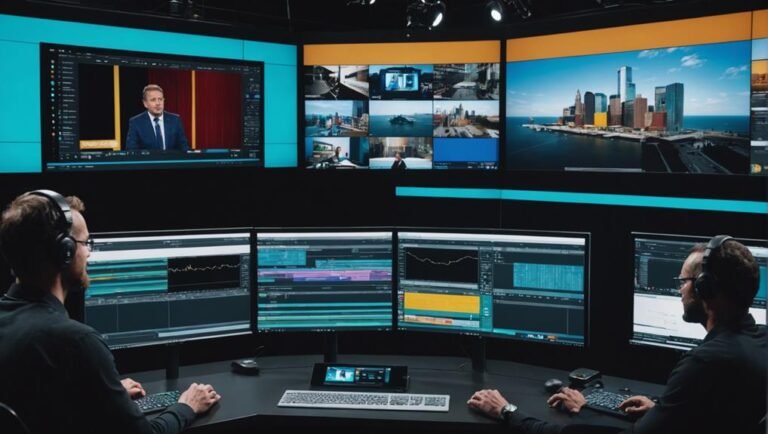When comparing CCD to CCTV, remember that CCD (Charge-Coupled Device) focuses on capturing high-quality, detailed images, especially in low-light conditions. CCD sensors excel in image clarity, color accuracy, and low noise. On the other hand, CCTV (Closed-Circuit Television) systems are geared towards security and monitoring, offering features like 24/7 surveillance, remote access, and motion detection. CCTV is perfect for property monitoring and acts as a crime deterrent, whereas CCD tech gives you superior image quality. Looking to understand more about how each works and which suits your needs? Keep going for deeper insights.
What Is CCD?
CCD, or Charge-Coupled Device, is a type of image sensor used in cameras to convert light into electronic signals. If you’re someone who values capturing the essence of a moment without compromise, understanding CCD technology is crucial. These sensors are known for their exceptional image quality, making them a favorite among photographers who crave freedom in their creative expression.
When you use a camera with a CCD sensor, you’re leveraging a technology that excels in low-light conditions and offers high dynamic range. This means you’ll get crisp, vibrant images even when the lighting isn’t ideal. CCD sensors capture light through a grid of tiny pixels, each transferring its charge to the next until the entire image is read. This process minimizes noise and ensures sharp, detailed photos.
Don’t let technical jargon bog you down—think of CCD as the heart of your camera that lets you seize those fleeting moments with clarity and precision. Whether you’re photographing the vast landscapes of your travels or the intimate details of everyday life, CCD technology empowers you to do so with unmatched quality. Embrace this tech, and let your creativity run wild.
What Is CCTV?
Closed-Circuit Television (CCTV) systems are essential for enhancing security and monitoring activities in various environments. Whether you’re safeguarding your home, business, or public space, CCTV gives you the ability to oversee things without being physically present.
Imagine the freedom of knowing that your property is monitored 24/7. CCTV employs a network of cameras that capture footage and transmit it to a set of monitors. This footage can be recorded and reviewed, providing you with valuable evidence if any incidents occur. Plus, modern systems offer features like motion detection, night vision, and remote access, allowing you to check in from anywhere via your smartphone or computer.
You don’t have to be tied to one location to make sure everything is running smoothly. With CCTV, you can travel, work remotely, or simply relax, knowing that you have a reliable security system in place. It’s about taking control of your environment and safeguarding what matters most to you. CCTV systems offer you peace of mind and the freedom to live your life without constantly worrying about security threats.
How CCD Works
Explore the mechanics of a Charge-Coupled Device (CCD) to understand how it captures and processes images in your security system. When light enters the CCD, it hits an array of tiny, light-sensitive cells called pixels. Each pixel converts the light into an electronic charge. The amount of charge depends on the intensity of the light hitting it.
Next, these charges get transferred across the chip, one row at a time, like a bucket brigade. This transfer process is what makes CCDs unique and highly effective for capturing high-quality images. Once the charges reach the edge of the chip, they get converted into a voltage. This voltage is then amplified and digitized to create a digital image you can view.
Here’s a simple breakdown of how a CCD works:
| Step | Description |
|---|---|
| Light Capture | Light hits the pixels, creating an electronic charge. |
| Charge Transfer | Charges move across the chip, row by row. |
| Conversion | Charges convert to voltage at the chip’s edge. |
| Image Creation | Voltage is digitized to form the final image. |
Understanding CCD technology empowers you to make informed decisions about your security systems. With CCDs, you’re choosing precision and clarity, ensuring you capture every detail.
How CCTV Works
Understanding how CCTV works can give you the confidence to effectively monitor and secure your environment. CCTV, or Closed-Circuit Television, involves using cameras to transmit video footage to a specific set of monitors. The “closed-circuit” part means that the broadcast is not public, guaranteeing your privacy.
First, you install cameras at strategic locations around the area you want to secure. These cameras capture video footage and send it to a recording device. Modern CCTV systems often use DVRs (Digital Video Recorders) or NVRs (Network Video Recorders) to store the footage digitally. This setup allows you to review past recordings and keep evidence if needed.
Next, you’ll connect your cameras to a monitor or a series of monitors, where you can view the footage in real-time. Many systems also allow remote access through smartphones or computers, giving you the freedom to check in from anywhere.
Additionally, some advanced CCTV systems come with motion detection and alert features. This means you get notifications if the system detects any unusual activity, helping you respond quickly to potential threats. With this setup, you can maintain control and safeguard the safety of your space.
Benefits of CCD
Harnessing the advantages of CCD (Charge-Coupled Device) technology can greatly enhance the quality and reliability of your surveillance system. You’ll appreciate the superior image quality that CCD cameras offer, thanks to their high sensitivity to light. This means you can capture clearer, more detailed images even in low-light conditions, giving you the freedom to monitor your property effectively at any time of day.
Another benefit is the low noise level associated with CCD sensors. When you need accurate and clean images, CCD technology delivers by reducing the graininess and distortion that can plague other types of cameras. This clarity can be essential in identifying faces or license plates, which adds an extra layer of security to your surveillance efforts.
CCD cameras also excel in color accuracy. The technology ensures that what you see on the screen is a true representation of the scene, helping you make more informed decisions based on reliable data.
Lastly, CCD cameras are known for their durability and longevity. When you invest in a surveillance system, you want it to last. With CCD technology, you’re choosing a robust solution that stands up to the test of time, freeing you from frequent replacements and maintenance hassles.
Benefits of CCTV
While CCD technology offers impressive advantages, it’s equally important to recognize the wide-ranging benefits that CCTV systems bring to your overall security strategy. CCTV systems empower you to monitor your surroundings in real-time, giving you the freedom to act swiftly whenever an issue arises. They serve as an effective deterrent against potential intruders and can greatly lower the risk of crime in your area.
Moreover, CCTV systems offer you the convenience of remote monitoring. You can check live feeds from your smartphone or computer, no matter where you are. This flexibility ensures that you can keep an eye on your property even while you’re away, enhancing your peace of mind.
| Feature | Benefit |
|---|---|
| Real-time Monitoring | Immediate response to incidents |
| Deterrence | Reduces likelihood of crime |
| Remote Access | Monitor from anywhere, anytime |
| Evidence Collection | Provides essential data for authorities |
Additionally, CCTV footage can be invaluable for evidence collection. In case of an incident, you have concrete proof that can aid law enforcement in their investigations. This not only enhances your security but also supports justice within your community. By integrating CCTV systems into your security plan, you promote a safer environment for yourself and those around you.
CCD Vs CMOS Sensors
When comparing CCD and CMOS sensors, it’s important to understand how each technology influences the performance and efficiency of your security system. CCD sensors excel in low-light conditions and provide higher image quality with less noise. This is because they use a process that captures light in a single, uniform transfer, resulting in clear, detailed images. If you’re looking for crisp footage, especially at night, CCD might be your go-to.
On the other hand, CMOS sensors are all about flexibility and cost-effectiveness. They consume less power and offer faster processing speeds, which can be essential if you’re setting up a large-scale system. CMOS technology allows each pixel to be read individually, making it possible to integrate more functions directly onto the sensor. This translates to cheaper, more versatile cameras that can fit a range of needs.
Choosing between CCD and CMOS boils down to your priorities. Do you value high-quality images in challenging lighting, or does efficiency and cost take precedence? By understanding these key differences, you’re better equipped to tailor your security setup to your specific requirements, ensuring your freedom to monitor your space effectively.
Choosing Your System
Now that you understand the differences between CCD and CMOS sensors, it’s time to decide which type of security system best fits your needs. If you value high image quality and low noise, especially in low-light conditions, a system with CCD sensors might be your best bet. They capture detailed images, making them perfect for environments where clarity is essential.
On the other hand, if you’re looking for something more energy-efficient and budget-friendly, CMOS sensors are ideal. They offer faster processing speeds and integrate well with modern technology. They might not provide the same image quality as CCD, but they’re excellent for general surveillance and everyday security needs.
When choosing your system, consider your environment and specific requirements. For instance, if you need to monitor a large, well-lit area, CMOS might suffice. But if you’re overseeing a dimly lit warehouse or a night-time outdoor space, CCD’s superior low-light performance will serve you better.
Don’t forget to think about installation and maintenance. CCD systems can be more complex and expensive to maintain, while CMOS systems are generally easier to handle. Ultimately, the choice depends on balancing your need for quality, cost, and convenience.
Frequently Asked Questions
What Are the Common Applications of CCD Technology Outside of Security?
You’ll find CCD technology in many fields beyond security. It’s used in digital cameras for stunning images, telescopes for capturing the cosmos, and medical imaging devices. Embrace the freedom to explore its diverse applications!
How Do Environmental Conditions Affect the Performance of CCD and CCTV Systems?
So, you love freedom but want reliable surveillance? Ironically, both CCD and CCTV systems can be divas in harsh weather. Extreme temperatures, humidity, and dust can degrade their performance, making your quest for security a bit challenging.
What Is the Typical Lifespan of a CCD Sensor Compared to a CCTV Camera?
You’re probably wondering about lifespans. A CCD sensor typically lasts around 10 years, while a CCTV camera can last 5-7 years. Both can vary based on usage and environmental conditions, so keep that in mind.
Can CCD Sensors Be Used in Wireless CCTV Systems?
Imagine a world without tangled wires—yes, you can use CCD sensors in wireless CCTV systems. They’re compatible, giving you the freedom to install high-quality surveillance without the hassle of complicated wiring.
How Do Maintenance Requirements Differ Between CCD and Traditional CCTV Systems?
You’ll find that CCD sensors typically need less maintenance than traditional CCTV systems. CCDs have fewer moving parts and are more reliable, letting you focus on more important things rather than constant upkeep.



